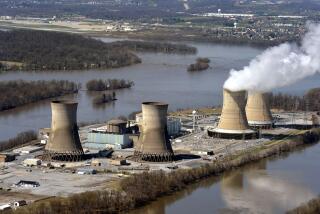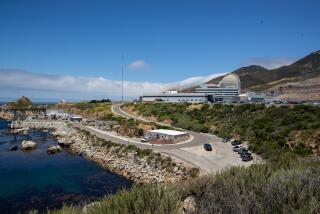San Onofre nuclear plant may resume partial service in June
The problems at the San Onofre nuclear power plant are serious enough that the facility will not be able to operate at full capacity when it reopens, perhaps as early as June.
The announcement comes as officials continue to investigate problems in the reactors that have forced the plant to remain shut for three months, the longest closure in San Onofreâs history.
Southern California Edison estimated that the companyâs cost for inspections and repairs at the plant would be between $55 million and $65 million. Costs to replace the power from the plant could be higher.
The company is preparing to ask the U.S. Nuclear Regulatory Commission to allow the Unit 2 reactor to be up and running in early to mid-June and Unit 3 one to three weeks later, Stephen Pickett, Edisonâs executive vice president of external relations, said Thursday.
The reactors would run at reduced power, probably 50% to 80%, and would be taken out of service for inspections a few months later. Officials said itâs possible the plants will never be able to return to full power.
The NRC, however, will need to give approval before the plant can restart.
The domed plant just south of San Clemente has been closed since Jan. 31, when a steam generator tube in the plantâs reactor Unit 3 began leaking, releasing a small amount of radioactive steam. Unit 2 was already offline for planned maintenance.
Since then, more than 500 of the plantâs nearly 39,000 tubes in both reactor units have been taken out of service due to excessive wear.
San Onofreâs four steam generators were replaced within the last several years at a cost of $671 million, an expense that is to be recovered from ratepayers.
Pickett characterized the problem as a âmanufacturing defectâ but said Edison has yet to determine whether the issue was caused by design problems or by the way the equipment was put together.
The issue appears to be caused by the level of steam flow through the tubes, which causes certain longer tubes to vibrate and rub against each other, he said.
Initially, officials said the tube-to-tube wear was confined to Unit 3, while the wear on tubes in Unit 2 was of a less unusual type, with tubes rubbing against support structures. But testing found two tubes at Unit 2 with tube-to-tube wear.
For the immediate future, operating the plant at less than full capacity is the only way to ensure that the issues do not resurface, Pickett said.
âWhether we can do something in the longer term to operate at greater power levels, in terms of a mechanical fix, has yet to be determined,â he said.
Officials said they hope to recoup their costs under Edisonâs $137-million warranty with Mitsubishi Heavy Industries, the manufacturer of the steam generators.
Edison also reported that it spent about $30 million for replacement power through March 31.
âTo the extent that the plant is not operating at full power, replacement power will have to be acquired elsewhere, so those costs will continue to rise,â Pickett said.
Mitsubishiâs warranty does not cover replacement power, so some or all of that cost may be passed on to ratepayers.
A Mitsubishi spokesman said the company could not comment on Edisonâs cost estimates but that the manufacturer âwill work diligently with our customer on issues such as future indemnification in accordance with our contractual agreements.â
San Onofre, when operating at full capacity, can provide power to 1.4 million households in Southern California. Some, including U.S. Rep. Darrell Issa (R-Vista), whose district includes the plant, have voiced hopes it would be back online before summer, when energy demand spikes in California.
But others say the plant has serious safety issues andshould be taken out of service for good.
Shaun Burnie, a nuclear consultant with the environmental group Friends of the Earth, which has put out reports alleging that design changes led to the problems and that Edison sidestepped NRC review, said he doesnât think operating the plant below full capacity will solve the problem.
âItâs pretty clear on the political side that this is Edisonâs attempt to strong arm the NRC into giving rapid approval,â he said.
More to Read
Sign up for Essential California
The most important California stories and recommendations in your inbox every morning.
You may occasionally receive promotional content from the Los Angeles Times.











